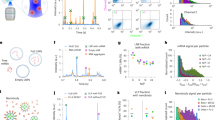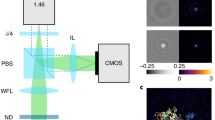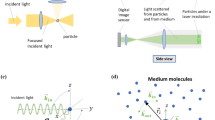Abstract
THE smallest spherical cell capable of an independent existence is believed to be, in theory, 100 nm. Bodies of this size have been found by electron microscopy in cultures of mycoplasmas but they are probably inviable1,3,4. The existence of living mycoplasmas as small as 125 nm is indicated by their ability to pass through filters of known porosity5–8, but the following experiments with Mycoplasma laidlawii lead one to believe that they are similar to erythrocytes in that they have an elastic cell wall and can therefore be squeezed through membrane filters with pores much smaller than their own diameters. They may, therefore, be larger than the smallest values quoted for mycoplasmas in the literature.
This is a preview of subscription content, access via your institution
Access options
Subscribe to this journal
Receive 51 print issues and online access
$199.00 per year
only $3.90 per issue
Buy this article
- Purchase on Springer Link
- Instant access to full article PDF
Prices may be subject to local taxes which are calculated during checkout
Similar content being viewed by others
References
Morowitz, H. J., Prog. Theoret. Biol., 1, 35 (1967).
Pirie, N. W., Proc. Roy. Soc., B, 160, 149 (1964).
Anderson, D. L., in The Mycoplasmatales and the L-phase of Bacteria (edit. by Hayflick, L.), 365 (Appleton-Century-Crofts, New York, 1969).
Anderson, D. L., Pollock, M. E., and Brower, L. F., J. Bact., 90, 1768 (1965).
Laidlaw, P. P., and Elford, W. J., Proc. Roy. Soc., B, 120, 292 (1936).
Elford, W. J., in Handbuch der Virusforschung (edit. by Doerr, R., and Hallauer, C.), 1, 126 (Springer, Vienna, 1938).
Klieneberger-Nobel, E., Pleuropneumonia-like Organisms (PPLO) Mycoplasmataceae, 61 (Academic Press, London and New York, 1962).
Tully, J. G., J. Inf. Dis., 115, 171 (1965).
Elford, W. J., Brit. J. Exp. Path., 10, 126 (1929).
Morowitz, H. J., Tourtellotte, M. E., and Pollack, M. E., J. Bact., 85, 134 (1963).
Taylor-Robinson, D., Williams, M. H., and Haig, D. A., J. Gen. Microbiol., 54, 33 (1968).
Bak, A. L., Black, F. T., Christiansen, C., and Freundt, E. A., Nature, 224, 1209 (1969).
Reynolds, E. S., J. Cell Biol., 17, 208 (1963).
Author information
Authors and Affiliations
Rights and permissions
About this article
Cite this article
LEMCKE, R. Sizing Small Organisms. Nature 229, 492–493 (1971). https://doi.org/10.1038/229492a0
Received:
Revised:
Issue Date:
DOI: https://doi.org/10.1038/229492a0
This article is cited by
-
Causality, Measurement, and Elementary Interactions
Foundations of Physics (2011)
Comments
By submitting a comment you agree to abide by our Terms and Community Guidelines. If you find something abusive or that does not comply with our terms or guidelines please flag it as inappropriate.



